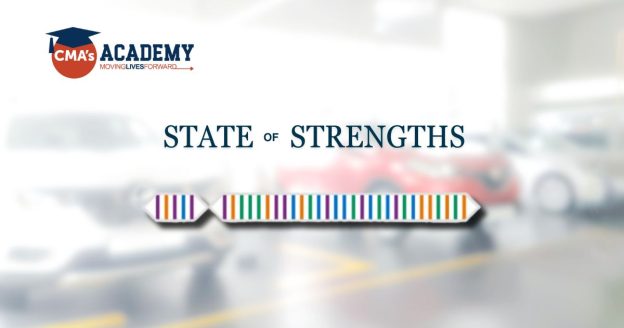What are the dominant strengths at CMA? How many associates have taken the assessment? Which strengths occur least frequently? What impact can this have on the workplace? Glad you asked!
We recognize the pivotal role that our associates play in driving success, delivering exceptional service, and fostering lasting customer relationships. That’s why we’ve embraced a strengths-based approach to cultivate a dynamic and empowered workplace culture.
How many associates have taken it?
Since launching the Strengths program in January, 324 associates have taken the CliftonStrengths assessment, which identifies your top areas of talent. Every associate is invited to complete the assessment, including new hires during their onboarding process. Our goal for 2024 is for 700 associates to complete it, so we’re almost half-way there.
What are the dominant strengths at CMA?
After taking the assessment, associates will receive a report of their top strengths. Of the 324 associates who have completed the assessment, the dominant strengths are:
#1: Achiever (41% of associates have this talent theme)
#2: Responsibility (34%)
#3: Relator (32%)
#4: Learner (27%)
#5: Positivity (22%)
When you look at the dominant strengths of everyone in the world who has taken the assessment, CMA is very comparable. The themes of Achiever, Responsibility, Relator, and Learner all appear on that list along with CMA. What’s different for CMA, however, is Positivity instead of Strategic on the world’s top five list.
What impact can these top five strengths have on CMA?
The prevalence of strengths such as Achiever and Responsibility underscores our team’s unwavering dedication to excellence and accountability. It speaks to a culture of hard work, perseverance, and pursuit of success that permeates every aspect of our operations. With associates who take ownership of their roles and commitments, we’re able to uphold the highest standards of quality and service.
The presence of strengths like Relator and Positivity highlights the importance of fostering genuine connections and a positive mindset. By prioritizing collaboration and a supportive environment, we can cultivate a community where team members feel valued, heard, and empowered to bring their authentic selves to work each day.
The Learner talent brings a capacity to learn, absorb new information, and experience new adventures. Having to learn something new when lacking knowledge or experience isn’t an obstacle for folks talented in the Learner strength.
What are the least frequent strengths at CMA?
We recognize that diversity in strengths is what truly enriches our collective experience and propels us forward. While some strengths may be more prevalent than others, we believe that each associate brings a unique set of talents and perspectives to the table.
Of the 324 associates who have completed the assessment, the least frequently occurring strengths are:
- Self-Assurance (11% of associates have this talent theme)
- Command (11%)
- Activator (16%)
- Significance (17%)
- Maximizer (18%)
We’re committed to embracing and harnessing the full spectrum of strengths present at CMA, including those less commonly found among our team members.
What impact can these less frequent strengths have on CMA?
The lower occurrence of Self-Assurance suggests that there may be opportunities to further develop confidence and self-belief. Providing support and encouragement, as well as creating a culture that values risk-taking and resilience, can help associates tap into their potential and approach challenges with greater confidence and assurance.
The lower prevalence of Command suggests that there may be fewer individuals who naturally gravitate towards assertive decision-making or communication. However, empowering associates to speak up when necessary and bring situational clarity can cultivate the Command talent at CMA.
Less of the Maximizer talent suggests that there may be opportunities to further enhance and refine existing practices and initiatives within CMA. Encouraging associates to leverage their strengths in maximizing potential and striving for excellence could lead to greater efficiency and effectiveness in various aspects of the business.
The lower frequency of Significance suggests that there may be an opportunity to further cultivate a sense of purpose and recognition among associates at CMA. Providing opportunities for employees to connect their work to the CMA’s mission and vision, as well as acknowledging their individual contributions, can help foster a greater sense of significance and fulfillment in their roles.
Finally, the lower frequency of Activator suggests that there may be room to encourage more proactive and decisive behavior among associates. Creating a culture that values and rewards initiative, innovation, and swift action can empower associates to take ownership of projects and drive positive change within the organization.
Conclusion
Our journey towards building a strengths-based workplace at CMA has just begun. By recognizing, embracing, and leveraging the diverse strengths of our team members, we’re not only fostering a culture of excellence and innovation but also creating a workplace where everyone can shine. If you haven’t taken the Strengths assessment yet or would like to request a workshop for your team, please visit the Strengths page on CMAPeople.
CliftonStrengths and the talent theme names are copyrights of the Gallup Organization. This post was assisted by ChatGPT.

Leave a Reply
You must be logged in to post a comment.